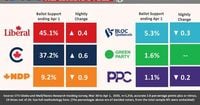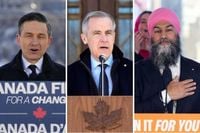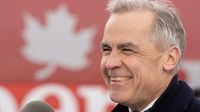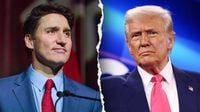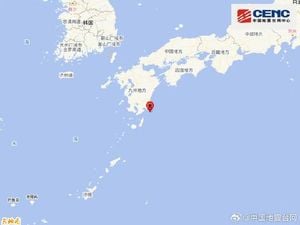As the Canadian federal election campaign enters its second week, the Liberal Party, led by Mark Carney, has managed to maintain a significant lead over the Conservative Party, headed by Pierre Poilievre. According to the latest polling data, the Liberals are currently enjoying an average voter share of 43 percent, while the Conservatives are trailing with 38 percent. The New Democratic Party (NDP) is far behind at just 8 percent, as reported by 338Canada, a polling aggregator.
The last notable poll indicating a Conservative lead was conducted by Nanos Research, which concluded on March 21, showing the Conservatives ahead at 36 percent to the Liberals’ 34 percent. Since then, the Liberals have surged ahead, with their highest recorded support at 48 percent in an EKOS poll concluded on March 28, giving them a 12-point edge over the Conservatives.
Despite this apparent advantage, experts caution against complacency. “Anybody who thinks that this thing is over…don’t,” warned Darrell Bricker, CEO of Ipsos, in an interview. He noted that minor fluctuations in polling numbers could significantly alter the campaign's trajectory as there are still 26 days remaining until the election on April 28, 2025.
A recent Angus Reid Institute poll revealed that a notable portion of new Liberal supporters has shifted from both the left and right. Specifically, 35 percent of these switchers previously supported the NDP, while 29 percent came from the Conservative ranks. Additionally, 12 percent of the switchers were previously aligned with the Bloc Québécois in Quebec. This shift could bolster the Liberal Party’s chances in the province, despite Carney's struggles with the French language.
Motivations for these shifts in support are varied. A significant 56 percent of the switchers cited Carney’s leadership as a motivating factor, while 51 percent pointed to Donald Trump’s policies towards Canada as a concern. Furthermore, 30 percent of respondents believed that voting for the Liberals would provide the best opportunity to defeat the Conservatives.
The NDP faces considerable challenges as its support dwindles due to the influx of Liberal switchers. NDP leader Jagmeet Singh acknowledged these difficulties, stating, “Let’s be clear, there’s massive challenges, I’ve got no illusions about that.”
Meanwhile, a recent Leger survey unveiled an intriguing statistic: 20 percent of Americans expressed a desire for their state to join Canada. This sentiment was particularly strong among young adults aged 18 to 34, with 30 percent in favor of such a move. However, 63 percent of Americans opposed the idea, and only 9 percent of Canadians believe annexation is likely.
Andrew Enns, executive vice president at Leger, attributed this interest to the polarization within the U.S., particularly regarding Trump’s unpopularity among certain demographics. He noted, “Trump and the Republican party’s stance on hot button issues such as abortion rights and immigration would certainly give some Americans reason to find refuge in Canada.”
In addition to the polling dynamics, the backdrop of the election is significantly influenced by the ongoing trade war with the U.S. Recently, President Trump announced a 10 percent tariff on all trading partners, adding to the existing 25 percent levy on foreign-made automobiles. This escalation prompted Carney to suspend campaign events and return to Ottawa to formulate Canada’s response.
During a cabinet meeting, Carney emphasized that Canada would respond to the tariffs “with purpose and force.” His anticipated news conference on April 3 is expected to outline the government’s strategy in addressing these tariffs.
On the other hand, Poilievre has been under pressure to adapt his campaign strategy to the evolving political landscape. During a gathering of Conservative supporters, he insisted he would continue to focus on issues of affordability and illicit drugs, despite calls to address the trade war more directly.
The Conservative Party has also faced internal strife, having dropped four candidates in just two days. The latest casualty is Don Patel, a candidate in the Toronto-area riding of Etobicoke North, who publicly supported the controversial idea of deporting individuals to India, a statement that the party deemed “clearly unacceptable.”
In the latest tracking by Nanos Research, the Liberals are leading by approximately 7.9 points, with 45.1 percent of decided voters backing Carney’s party, while the NDP’s support has dipped to 9.2 percent from 10.1 percent the previous day.
As the campaign unfolds, the narrative surrounding Canada-U.S. trade relations remains pivotal. David Coletto, CEO of Abacus Data, highlighted that Trump’s tariffs have left many Canadians anxious about the country’s position in an increasingly unpredictable international environment. “Liberals have seized on these concerns, positioning Mark Carney as the best captain in a storm,” Coletto remarked.
Amidst these developments, the polling landscape is showing signs of volatility. A March 27-29 poll from The Globe and Mail, CTV, and Nanos Research surveyed 1,182 Canadians, yet the demographic distribution raised questions about representativeness, particularly with a larger portion of older respondents. Critics have pointed out that only 158 individuals in the 18-34 age bracket were surveyed, compared to 733 in the 55+ category.
Despite these concerns, Carney appears to have a solid lead among older voters, with 50 percent of that demographic favoring him over Poilievre, who garnered 34 percent. However, as Bricker cautioned, “A six-point Liberal lead sounds big, but with a credibility interval of ±3.1 points, it’s not a slam dunk.”
As the election date approaches, the focus will undoubtedly remain on how the parties navigate the complex issues of trade, leadership, and voter sentiment, with the potential for significant shifts in the coming weeks.
